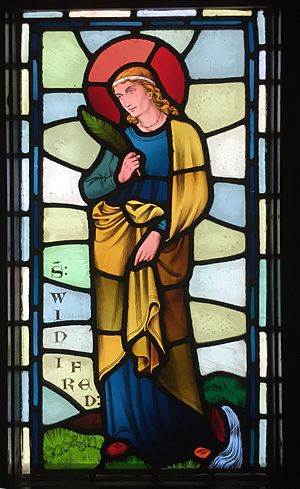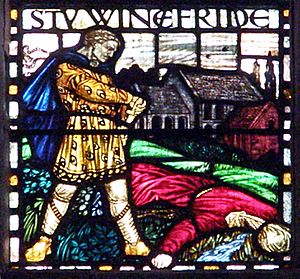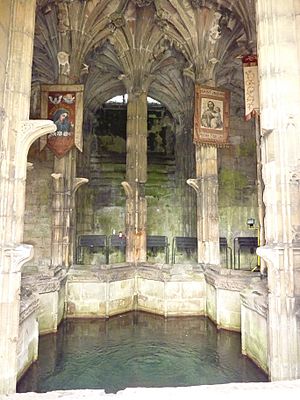Saint Winifred facts for kids
Quick facts for kids SaintWinifred or Winefride |
|
|---|---|

|
|
| Virgin, Martyr & Abbess | |
| Born | Tegeingl (modern-day Flintshire) |
| Died | c. 7th century Gwytherin (in modern-day Conwy) |
| Venerated in | |
| Major shrine | Shrewsbury Abbey, now destroyed although a small part of the shrine base survives. Holywell, fully active holy well and well-house shrine. |
| Feast | 3 November |
| Attributes | Abbess, holding a sword, sometimes with her head under her arm |
| Patronage | Holywell; against unwanted advances, Diocese of Shrewsbury |
Saint Winifred (also called Winefride) was a Welsh saint from the 600s. She is known as a virgin martyr, meaning she was a young woman who died for her Christian faith. Her story became very popular in England in the 1100s.
A special healing spring is found where her story says she was hurt. This place is now a shrine and a site for pilgrimage called St Winefride's Well. It is in Holywell, Flintshire, Wales. Many people call it "the Lourdes of Wales" because of its healing reputation.
Contents
The Story of Saint Winifred

The oldest written stories about Winifred are from the 1100s. Legend says Winifred was the daughter of a Welsh nobleman named Tyfid ap Eiludd. Her mother, Wenlo, was the sister of Saint Beuno. Her family was connected to the kings of south Wales.
Winifred's Miracle and the Holy Well
According to the legend, a man named Caradog wanted to marry Winifred. When she decided to become a nun instead, he became very angry. He then cut off her head. A healing spring appeared right where her head fell.
Saint Beuno, her uncle, helped to put Winifred's head back on her body. She was brought back to life! Beuno saw Caradog standing there, looking defiant. Beuno asked for God's punishment, and Caradog fell dead. People believed the ground opened up and swallowed him.
Before Beuno left Holywell, he sat on a stone that is still in the well pool today. He promised that anyone who prayed three times at that spot, asking God for help in Saint Winifred's name, would receive it if it was good for their soul.
Winifred's Life as a Nun
After eight years at Holywell, Winifred felt called to leave the convent. She went on a journey to find a new place to live. She eventually arrived at Gwytherin, near the River Elwy. There, she became a nun and later an abbess, which is the leader of a group of nuns. Some stories even say she went on a pilgrimage to Rome.
Is the Story True?
Because the first written stories of Winifred are from the 1100s, some people in the 1800s wondered if she was a real person. However, there is evidence that people honored her long before these stories were written.
In 1991, small pieces of an oak box from the 700s were found. These pieces were identified as belonging to the Arch Gwenfrewi, which was Saint Winifred's special box for relics. This box probably held a piece of her clothing or another item connected to her, not her bones.
Historian Lynne Heidi Stumpe says this box shows that Winifred was recognized as a saint soon after her death. This means she was likely a real person. This box might even be the oldest proof of any Welsh saint being formally honored.
Honoring Saint Winifred
People began honoring Winifred as a saint in the 1100s. She is mostly honored in England, not as much in Wales. In 1138, some of Winifred's relics were moved to Shrewsbury. This was done to create a special shrine there. The Church of St. Winifred, Stainton in England is a church from the 1100s named after her.
Her Story and Shrines

Most of what we know about Winifred's life comes from old writings. One important story was written around 1130 by Robert, who was the prior (leader) of Shrewsbury Abbey. Robert is known for making Saint Winifred's story more famous. He moved her relics to Shrewsbury Abbey and wrote the most important story about her life.
To make the Abbey even more important, Abbot Nicholas Stevens built a new shrine for Saint Winifred in the 1300s. He also had monks bring the relics of Saint Beuno to the abbey church. Even though the abbey was fined for this, they were allowed to keep the relics.
The shrine and well at Shrewsbury became popular places for pilgrimage in the late Middle Ages. However, the shrine was destroyed by King Henry VIII in 1540.

The well at Holywell is located below the town on a steep hill. The shrine of Saint Winifred (called Gwenffrwd or Gwenfrewi in Welsh) is one of the best examples of a medieval holy well in Britain. There is also an exhibition there that tells the story of the saint and her shrine. A museum about the pilgrimage is in the old house of the people who used to care for the well.
Another well named after Saint Winifred is in Woolston, near Oswestry in Shropshire. Legend says that when Winifred's body was being moved to Shrewsbury Abbey, it rested there overnight. A spring then appeared from the ground. People believe the water has healing powers for bruises, wounds, and broken bones. A 15th-century wooden cottage covers the well. The water flows into stone troughs and then into a large pond. The Landmark Trust takes care of the cottage.
Another spring is at Holywell Farm, between Tattenhall and Clutton, Cheshire. This spring is also said to have appeared when Winifred's body was laid down. It provides drinking water for two houses.
A spring on Lansdown Hill, Bath was known as St. Winifred's Spring. It gave its name to a nearby lane. There is no clear link to Saint Winifred's life, but people once believed its waters helped women have children.
A Norman church dedicated to Saint Winifred is in the village of Branscombe, Devon. There is some proof that an older Saxon church might have been there before.
Official Recognition
In the 2004 edition of the Roman Martyrology, Winifred is listed under November 2. This book lists saints recognized by the Vatican. She is described as "At the spring located at Holywell in Wales, St Winefride the Virgin, who is outstanding in her witness as a nun."
This means the Vatican officially recognizes Winifred as a real person who lived a very religious life. They do not discuss any miracles she may have performed or been healed by. As a saint from the first 1000 years of Christianity, she is recognized because people honored her, not because she was formally canonized (made a saint by official church process).
In the current Roman Catholic liturgical calendar for Wales, Winifred is remembered on November 3. This is because November 2 is already set aside for All Souls' Day.
How She is Shown in Art
When you see Saint Winifred in stained glass art, like in Llandyrnog and Llanasa, she is often shown learning. She is also shown as an honorary martyr. The third way she is shown is as a religious leader. On the seal of the cathedral chapter of St. Asaph, she appears as an abbess. She wears a wimple (a head covering) and carries a crozier, which is a staff that shows her leadership and authority. She also holds a reliquary, a container for relics.
Feast Days
- 22 (or 24) June - the day she died
- 30 October - feast day in Ireland
- 2 November - in the Roman Martyrology
- 3 November - feast day in England and Wales
Legacy
A statue of Saint Winifred stands overlooking the Hudson River in Hudson, New York.
See also


